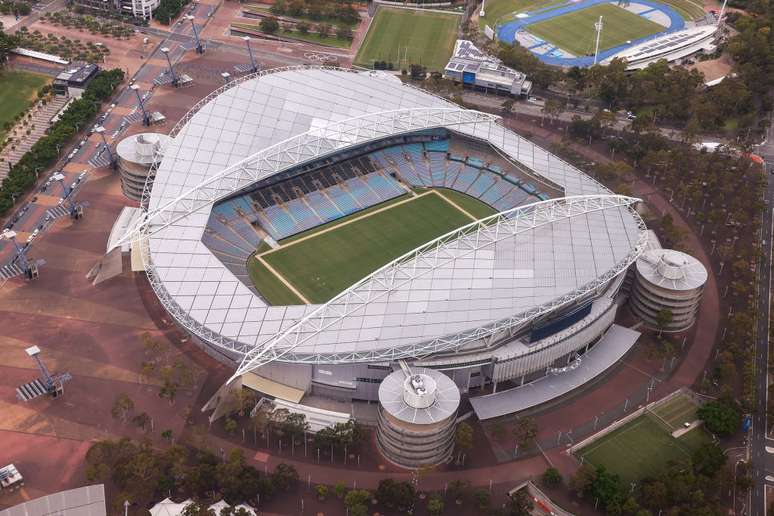The tournament will take place in Australia and New Zealand between July 20 and August 20; learn more about the competition venues
The 2023 Women’s World Cup will be the first edition of the tournament to be held in Oceania. Australia and New Zealand will receive the selections of the 32 participating countries and the Earth presents the stadiums that will host the Women’s World Cup. A Brazilian team debuts on July 24, at 8 in the morning, against Panama.
- Check out the 2023 Women’s World Cup standings
The Women’s World Cup will take place in 10 stadiums, spread across nine cities, including five in Australia and four in New Zealand. The first match will be played at Eden Park in Auckland between hosts New Zealand and Norway. The final will be played at the Olympic Stadium in Sydney, Australia. The semi-finals will take place one per country.
Discover the cities and stadiums of the Women’s World Cup 2023:
Sydney, Australia):
Capital of the state of New South Wales, Sydney is considered Australia’s most multicultural metropolis and has two stadiums that will host World Cup matches. Here is the Accor Stadium, the former Olympic Stadium in Australia, inaugurated in 1999 and with a capacity of 82,500 fans. The stadium will also host the final, round of 16, quarter-finals and semi-finals.
Melbourne, Australia):
The most populous city in the state of Victoria, Melbourne became Australia’s most populous urban area in 2023, overtaking Sydney. It is also one of the largest financial centers in the Asia-Pacific region.
It is home to Melbourne Rectangular Stadium, which opened in 2010, which has a capacity of just over 30,000 fans. Regularly used for rugby and cricket matches, the stadium will host four first round matches and two round of 16 matches, including the match between Brazil and Jamaica in the third round of the group stage.
Perth (Australia):
The largest metropolis in the state of Western Australia, Perth built its wealth on gold exploration. Today with more than 2 million inhabitants, it is one of the main commercial and industrial centers of the country and will also host the Women’s World Cup.
The matches will take place at the Perth Rectangular Stadium, which is used for both sporting events and music concerts. Founded in 1910 and with a capacity of 20,500 fans, the stadium will host five World Cup matches.
Brisbane (Australia):
Third Australian city by population, Brisbane is the capital of the state of Queensland and is considered an important economic, administrative, cultural and urban center of the country. Cup matches in the city will take place at Brisbane Football Stadium, known as Lang Park.
The stadium was founded in 1914 and has a capacity of 52,500. Five group stage matches will be played there, including the match between Brazil and France in the 2nd round, one round of 16 match, one quarter-final match and the dispute for 3rd place.
Adelaide (Australia):
Capital of the state of South Australia, Adelaide is the fifth most populous city in the country, with 1.2 million inhabitants. Located on the south coast of Australia, it is known for offering religious freedom, political progressivism and social freedoms.
Adelaide is home to Hindmarsh Stadium, a polyarena with a capacity of 16,500 and founded in 1960. In the World Cup, the stadium will host four group stage matches, including Brazil opener against Panama and a round of 16 final of final.
Auckland, New Zealand):
New Zealand’s largest city, Auckland is the island country’s main financial and economic hub. The metropolis has a population of 1.4 million and is curiously located in an area close to 53 volcanoes, as well as dozens of geysers.
It is there that Eden Park is located, the stage for the opening of the 2023 Women’s World Cup and the inaugural match between hosts New Zealand and Norway. Founded in 1900 and with a capacity of 50,000, the stadium will host five group stage matches, one round of 16 match, one quarter-final match, as well as one semi-final match.
Wellington (New Zealand):
The capital of New Zealand, with a population of 212,000 in the urban area, is close to a natural harbor and most of the population lives in mountainous areas. It is known for its rich cultural centre, with regional museums, a symphony orchestra and the concentration of New Zealand film production.
The capital’s stadium is the Wellington Regional Stadium, founded in 1999 and with a capacity of 34,500 people. Seven group stage matches, one round of 16 and one quarter-final match will be played there.
Dunedin (New Zealand):
The metropolis is the second largest city in the South Island of New Zealand and the principal city of the Otago region. Its roots are in Maori, Scottish and Chinese cultures. The city grew during the period of gold exploration in the region and, today, has become a center for the arts, tourism and technological development.
In the metropolis, Cup matches will be held at Forsyth Barr Stadium, also known as Dunedin Stadium, founded in 1999 and with a capacity of 30,748 fans, where six group stage matches will take place. It is the only stadium in the world that is completely covered and with natural grass.
Hamilton (New Zealand):
Known as New Zealand’s most beautiful city, Hamilton began as an agricultural center but has developed into education and research. It currently has a population of approximately 179,000 people.
It is also home to the 25,800-capacity Waikato Stadium, which opened in 2002. The stadium will host five group stage matches of the Women’s World Cup.
-
Accor Stadium, Australia
Photo: Getty Images/David Gray
-
Sydney stadium in Australia
Photo: Getty Images/Cameron Spencer
-
Rectangular stadium in Melbourne Australia
Photo: Getty Images/Darrian Traynor
-
Rectangular stadium in Perth, Australia
Photo: Getty Images/Paul Kane
-
Brisbane Stadium, Australia
Photo: Getty Images/Bradley Kanaris
-
Hindmarsh Stadium, Australia
Photo: Getty Images/Mark Brake
-
Eden Park in New Zealand
Photo: Getty Images/Mark Meredith
-
Wellington stadium in New Zealand
Photo: Hagen Hopkins/Getty Images
-
Waikato Stadium, New Zealand
Photo: Michael Bradley/Getty Images
-
Stadium in Dunedin, New Zealand
Photo: Joe Allison/Getty Images
Share
Source: Terra
Rose James is a Gossipify movie and series reviewer known for her in-depth analysis and unique perspective on the latest releases. With a background in film studies, she provides engaging and informative reviews, and keeps readers up to date with industry trends and emerging talents.







